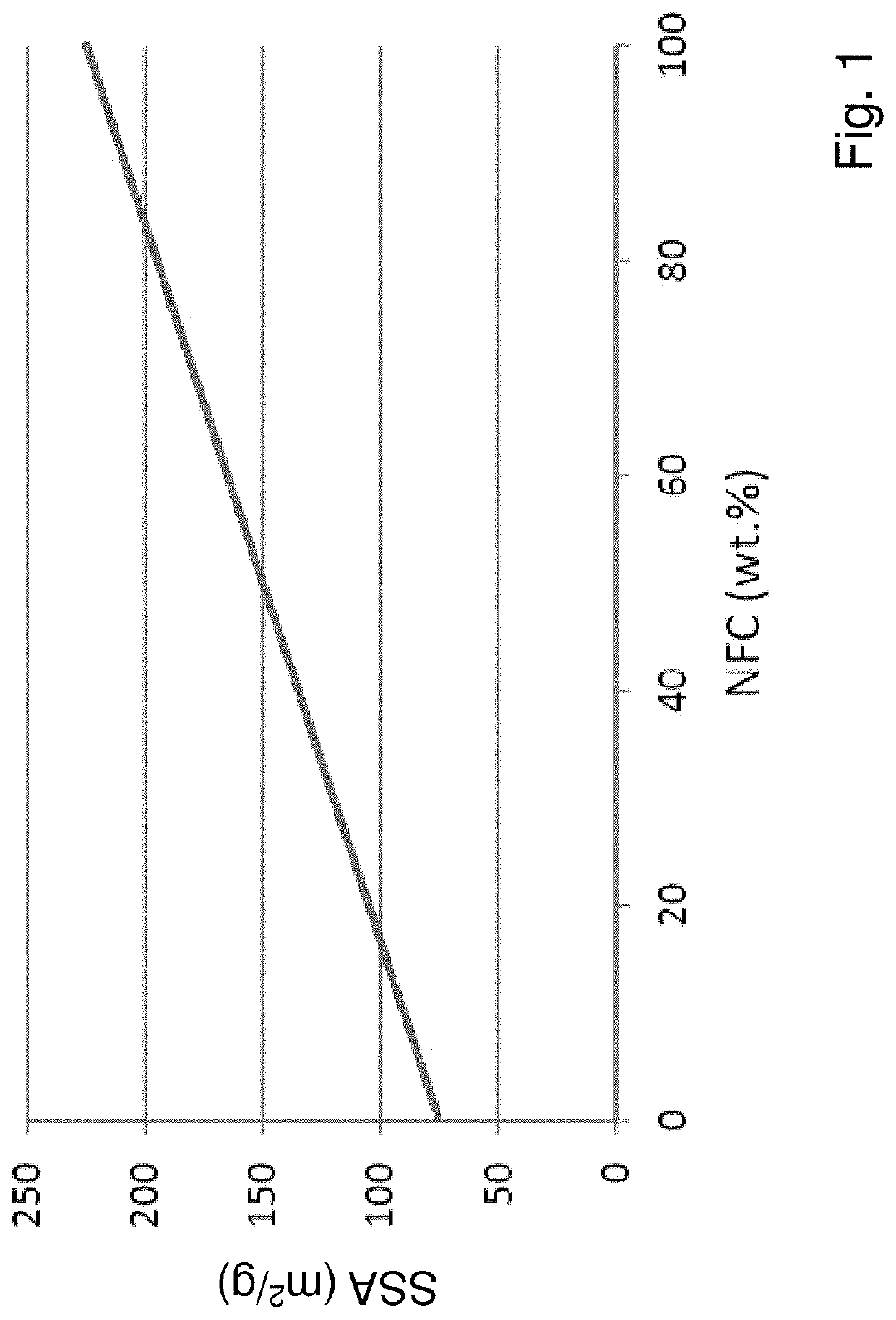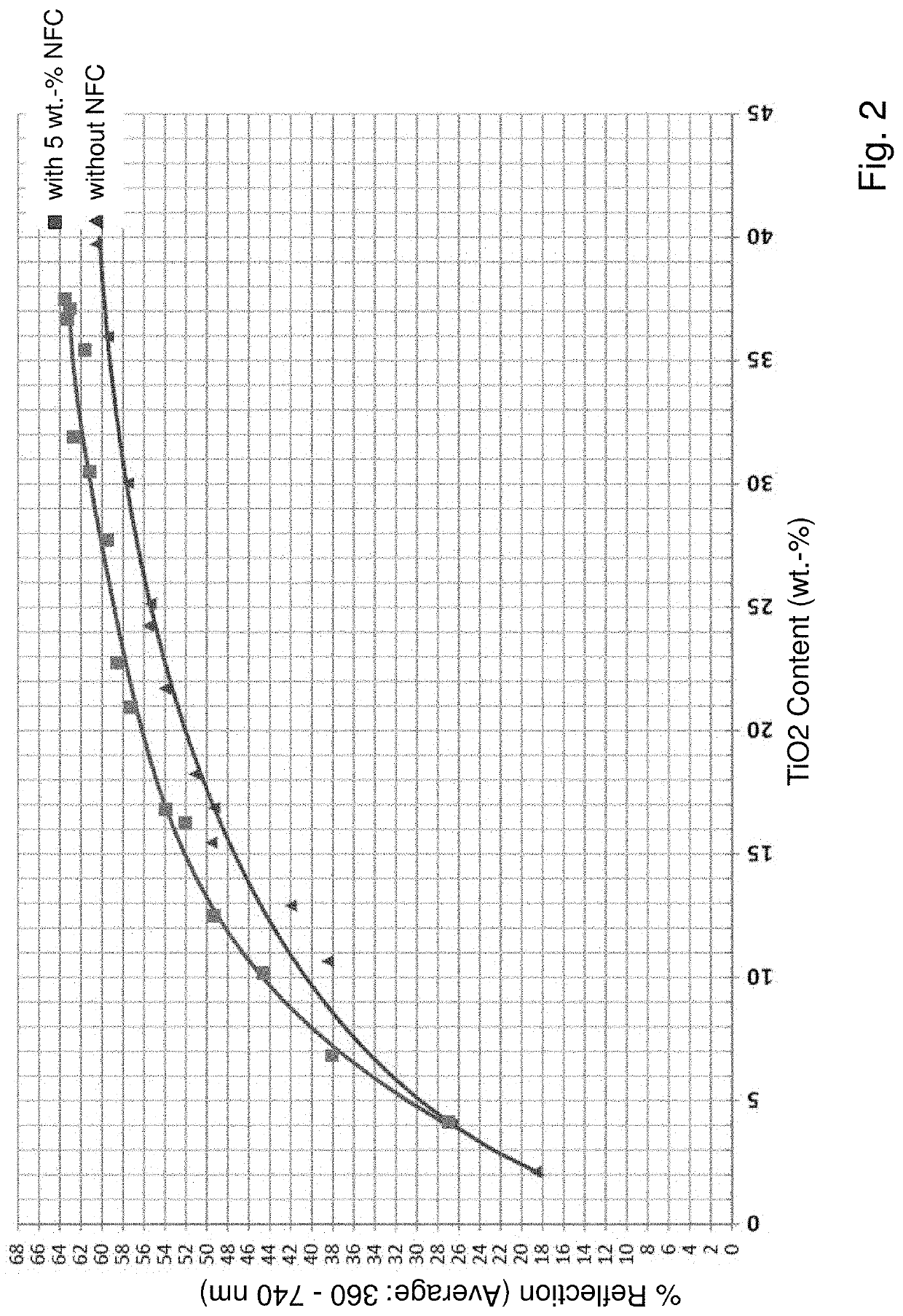Fibrous substrate for producing a porous coating base paper or prepreg, and method for the production thereof
a technology of fibrous substrate and coating base paper, which is applied in the field of fibrous substrate material, can solve the problems of unattainable commercial limits for the reasonable use of pigments and fillers, cyclical price fluctuations, and immense pressure on pigments and fillers, and achieves the effects of reducing air permeability, reducing gurley value, and improving air permeability
- Summary
- Abstract
- Description
- Claims
- Application Information
AI Technical Summary
Benefits of technology
Problems solved by technology
Method used
Image
Examples
example 1
[0057]As shown in FIG. 1, the specific surface area SSA in m2 / g of NFC containing cellulose increases linearly as a function of the weight proportion of NFC. While, in the example shown, it is only about 75 m2 / g for conventional cellulose without NFC addition, it has values of around 225 m2 / g in the case of 100% NFC; for more details see: Josset, S. et al. Energy consumption of the nanofibrillation of bleached pulp, wheat straw and recycled newspaper through a grinding process. Nordic Pulp &Paper Research Journal 29, 167-175 (2014).
[0058]For a comparative evaluation of the properties of conventional coating base papers without NFC and of such base papers with NFC, paper blanks with a constant pulp density of 50 g / m2 and progressively larger TiO2 contents were produced by means of a sheet former (Estanit, Mülheim an der Ruhr, Deutschland, based on DIN EN ISO 5269-2-DIN 54358).
[0059]Bleached pulp made of wood fibers was ground by a standard method to a Schopper-Riegler value of 35 SRº...
example 2
[0065]Several sections of monolayer fibrous substrate material were produced using NFC of various types, i.e. with different values of the specific surface area (SSA), in the above-mentioned manner. The ash content in wt.-% was used as a standard measure of the retention capacity of the mineral components, here in particular of titanium dioxide. The following results each are given as the mean of 3 measurements.
[0066]For the production without NFC considered as reference base, an ash content of 30.8 wt.-% was found.
[0067]Using an NFC with a SSA of about 95 m2 / g (prior art), the ash content was 32.6 wt.-%, which corresponds to an absolute increase of 1.8 wt.-% compared to the reference.
[0068]Using an NFC with a SSA of about 165 m2 / g (according to the present invention), the ash content was 38.9 wt.-%, which corresponds to an absolute increase of 8.2 wt.-% compared to the reference.
[0069]Using an NFC with a SSA of about 225 m2 / g (according to the present invention), the ash content wa...
PUM
| Property | Measurement | Unit |
|---|---|---|
| length | aaaaa | aaaaa |
| length | aaaaa | aaaaa |
| length | aaaaa | aaaaa |
Abstract
Description
Claims
Application Information
 Login to View More
Login to View More - R&D
- Intellectual Property
- Life Sciences
- Materials
- Tech Scout
- Unparalleled Data Quality
- Higher Quality Content
- 60% Fewer Hallucinations
Browse by: Latest US Patents, China's latest patents, Technical Efficacy Thesaurus, Application Domain, Technology Topic, Popular Technical Reports.
© 2025 PatSnap. All rights reserved.Legal|Privacy policy|Modern Slavery Act Transparency Statement|Sitemap|About US| Contact US: help@patsnap.com


